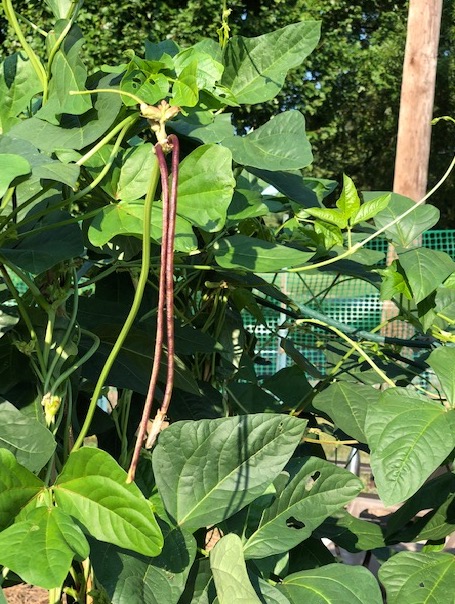International Gardener
Yard-Long Chinese Red Noodle Beans
By Pat Dickey, Fairfax Master Gardener
 Last winter, when I was reading through seed catalogs and trying to decide which new vegetables I wanted to grow, I became intrigued by the many international varieties. One type especially caught my attention: yard-long beans. For many summers, I have wanted to grow beans that would be plentiful and hopefully insect-free, and not attract Mexican bean beetles. From what I read, yard-long beans seemed to have these qualities, so I decided to give them a try.
Last winter, when I was reading through seed catalogs and trying to decide which new vegetables I wanted to grow, I became intrigued by the many international varieties. One type especially caught my attention: yard-long beans. For many summers, I have wanted to grow beans that would be plentiful and hopefully insect-free, and not attract Mexican bean beetles. From what I read, yard-long beans seemed to have these qualities, so I decided to give them a try.
Asparagus beans is another name for yard-long beans, with a similar appearance and texture of asparagus, but with a mild almost nutty taste. They look like pole snap beans but are more related to southern peas or cow peas. They originated in southeast Asia in the 11th century and are now grown in Asia, Europe and, recently, in the warmer areas of the United States. Their Latin name is Vigna unguiculata ssp. sesquipedalis. In China, they are known as Dow Gauk; in Japan, they are Sasage. The sub-species name sesquipedalis means one-half yard, which is a more accurate description of their length. They are 12 to 18 inches long and grow on a twisting vine in pairs around poles. Their compound leaves are large and tropical with three heart-shaped leaflets, and their flowers have five petals and are white, pink or lavender.
When planting the beans, first soak them overnight for quicker germination. Add compost to the area before you plant. Plant the seeds ¾ inch deep and 4 to 6 inches apart. They need 6 to 8 hours of sun per day. They sprout quickly, and their tendrils will be looking for something to latch onto, so erect the trellis when you plant the beans. I am glad that we built a very stable trellis with bamboo poles and with extra reinforcements horizontally across the top. Thankfully it stayed upright through the recent rain and windstorms. The trellis will continue to be top-heavy with beans, so you will need to add extra poles as needed to keep it balanced. No other fertilizer is needed.

My beans
There are several types of asparagus beans. I chose to grow the Chinese Red Noodle Beans. The red color is attractive and draws a lot of attention from visitors to our community garden. They are ready for picking after 59 days. Green Pod Red Seed Asparagus Beans that are dated back to pre-1860 will grow longer in length than the Red Noodle Beans but should be picked when tender at 18 inches. Another variety, Liana Asparagus Beans, are ready to pick a little earlier. The Purple Podded Asparagus Beans take the longest time on the vine at 79 days. There are also White Galaxy Asparagus Beans that are a little earlier than all the rest. If you want a smaller variety, try Stickless Wonder Asparagus Beans that do not require a trellis. However, they do not produce beans for as many days as the other varieties.
There are many ways to prepare these beans for eating. The young stems and leaves are also edible. They can be sautéed in olive oil, steamed or added to stir-fries. They can also be used in Thai and Indian curries. I snap or cut the beans into 3-inch pieces first before cooking. You will need to boil them for about three minutes beforehand if they are more mature, since these beans are more tough. You will be able to tell which ones are mature by the circumference of the beans and whether you see beans forming inside the pods. I try to pick the beans when they are the size of a pencil.
Why don’t you add these beans to your plans for next summer’s garden?
References
• Spill the Beans: Grow Yard Long Beans, Jane Callier, University of California Master Gardeners of
Napa County
• Sichuan Style Stir-Fried Chinese Long Beans, Simply Recipes
• Yardlong Bean, Plant Guide, U.S. Department of Agriculture
• Asparagus Beans, Southern Exposure Seed Exchange